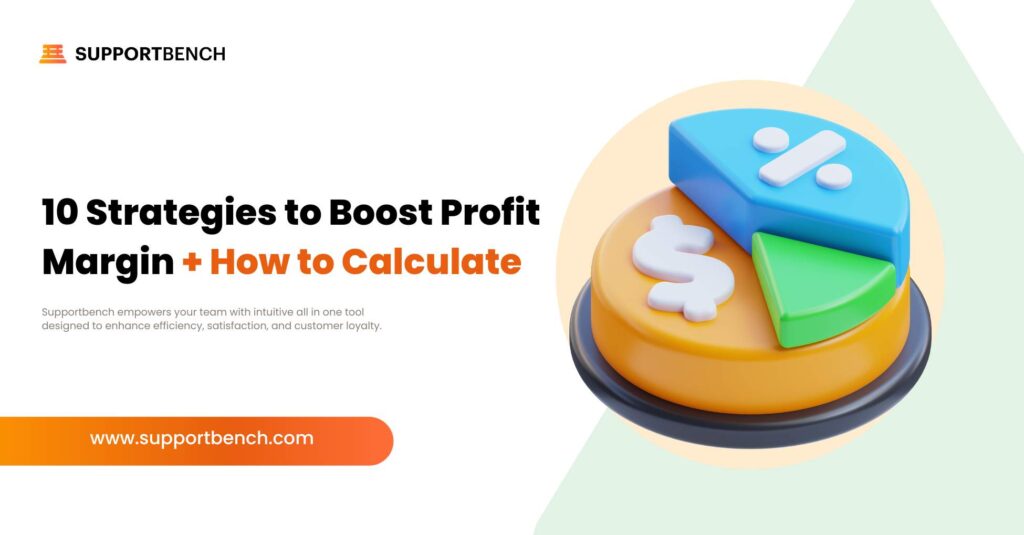Profit margin is one of the most critical metrics that could indicate a firm’s financial health and profitability level. In addition to showing how a business is working out its efficient profits in comparison to its revenue, it also helps companies to identify areas where they should improve with regards to cost management and pricing strategy.
Understanding the concept of profit margin is key for businesses that would like to improve their performances, especially in customer support.
At Supportbench, we make it possible for organizations to take customer service to the next level and ensure a high level of efficiency, with the aim of boosting profit margins.
We will equip you with managing tickets, automating workflows, and offer deep analytics. As a result, Supportbench enables companies to optimize operations, clear out inefficiencies, and foster better customer relationships. All these translate into much healthier profit margins.

What is Profit Margin?
Before we dive into the world of calculations and strategies, let’s take a moment to understand what profit margin technically means. This key measure shows how healthy and promising your business is. It lets you know what percentage of your revenue becomes profit once expenses are paid.
It gives you efficiency and success for your company. As we delve into profit margin, keep in mind that you are learning a significant tool to generate growth and make businesses sustainable.
Here are some important sales terms related to profit margins:
Cost: The money spent to produce your products or provide your services.
Margin: The difference between what you sell your products or services for and what it costs to make them.
Revenue: The total income your business earns.
Profit: The difference between what you earn and what you spend to produce your goods.
Different Types of Profit Margin
When speaking about the financial health of your business, three important terms are taken into consideration: ‘gross profit margin,’ ‘net profit margin,’ and operating profit margin.’ Although these words sound quite similar, each has a different role to play in understanding your finances.

Gross Profit Margin
The gross profit margin tells you how much cash you have on hand after paying for the direct costs of producing your products or services. It is indicative of production efficiency.
This will help you answer such questions as: How good are you at converting raw materials into money? Are your prices right?
A high gross profit margin means you are producing and selling efficiently. A low gross profit margin may indicate that you will have to go over your production cost or pricing.
Net Profit Margin
It’s a consideration of all costs: direct and indirect. This is the actual profitability margin after deducting all expenses, taxes, and interest from your books of accounts.
It will show if your total revenue covers all costs and still leaves something in the way of profit. A good net profit margin means that your business is doing great, and you can reinvest and expand your operations.
Operating Profit Margin
This margin measures the profitability of your core business operations before accounting for taxes and interest. Unlike gross profit margin, which only considers direct production costs, operating profit margin includes operating expenses such as wages and overhead but excludes external factors like taxes and financing costs.
This metric gives a clearer picture of how well your main business activities are generating profit, helping you assess the efficiency of your operations. It’s particularly useful for making decisions about scaling, investments, or identifying areas where operational improvements are needed.
How to Calculate Profit Margin
Here’s how to calculate each type of profit margin:
- Gross Profit Margin: Use the formula (Revenue – Cost of Goods Sold) / Revenue x 100. This shows the percentage of revenue that is more than your basic production costs.
- Net Profit Margin: Use the formula (Net Profit / Revenue) x 100. This calculates the percentage of revenue that remains after subtracting all expenses, both direct and indirect.
- Operating Profit Margin: Use the formula (Operating Profit / Revenue) x 100. Operating profit is your revenue minus the direct costs of producing goods or services and all operational expenses, like rent, utilities, and salaries. This margin does not include taxes, interest, or other non-operational costs.

What Is a Good Profit Margin?
Because profit margins vary from industry to industry, even from business to business, you cannot compare the profit margins of a company in one industry with those of another company in another industry.
For example, it will not make sense to compare a retailing company with an oil and gas company. However, you can make some guesses about the performance of a business through profit margins. A profit margin around 20% is good, whereas 10% is normal. A margin of 5% or less may indicate problems.
Studies, like one from New York University, show profit margins differ widely by industry. Some industries’ margins may be as low as -29%, while others reach upwards of 33%. For example, the casino and gaming sector is averaged at -28.56%, whereas the profit margin percentage averages 32.61% for banks.
This gives owners a rough idea of where their individual businesses’ profit margin stands compared to competitors on a regular basis to know if they are on pace.
10 Helpful Strategies for Maximizing Your Profit Margin
The tips below can help your business earn more money and cut costs to boost your profit margin.
Find and Fix Inefficiencies
To increase your profit margin, identify inefficiencies in each business part and find ways to save money or hours without compromising quality or service.
Focus on production costs, customer acquisition and retention strategies, manufacturing processes, operational expenses, sales gaps, and the competitive landscape.
By making adjustments at a time, you can continue to widen your profit margin by reducing costs and improving overall efficiency.
Develop Sales Strategies
Sales strategies for pricing, positioning, and promoting products and services will attract customers and enhance revenue. Evaluate resources supporting sales and marketing to identify strategies that offer ongoing revenue.
Take the time to evaluate the expense of current sales strategies to identify which strategies need to be changed.
Set Goals
You do not have to drastically change the profit margin right away. Instead, set realistic and measurable goals on a quarterly basis for example. After all, small, steady growth will help your business more than a high increase in profit followed by a drop.
Even though it is good to have one big goal in terms of growth, build up smaller milestones to ensure you achieve it. Consistent, small, and step-by-step actions will yield better results than making major changes every few months.
Reduce Costs
To maximize efficiency, a business needs to cut down operation costs like utilities, spending, subscriptions, and materials. For example, a business can renew subscriptions at lower rates or even change to lower levels of unused technology.
To improve profit margins, companies often look to eliminate unnecessary expenses and reduce costs. Also, when sourcing materials for production, find the most cost-effective options, of course without compromising on the quality. You can negotiate lower prices for longer contracts with current suppliers to save on production costs.
Build Trust in Your Brand
Customers are more likely to buy from businesses they trust. It can be hard for them to buy from a brand for the first time. Building a connection with your audience helps create trust and loyalty, which leads to more sales over time.
You can improve your reputation by using consistent colors, logos, fonts, and messages. Social proof, like reviews and testimonials, can help convince customers who are unsure about buying. Showing feedback from people similar to your target market can encourage potential customers and boost sales.
Up-sell, Cross-sell, Resell
It is costly to attract new customers. Savvy companies work on increasing their sales to their present customers by offering them more products via upselling, cross-selling, and reselling.
Train all sales reps in upselling techniques so that they may discuss options but not push customers. Employ an educational approach to show how the premium features will benefit the customer. Easy-to-understand comparisons, like charts or graphics, can enable customers to appreciate the differences between similar products.
Another simplified approach to boost sales is cross-selling. Consider promotions that reveal new items to your customer, such as promoting a free bottle of shampoo with the sale of a hairspray.
Sales representatives can also suggest items that go well together, saying something like, “I brought this top for you to try with those pants.” In addition, promote personalized options on products based on what customers have in their online carts.
Reselling is another way to generate revenue from existing products. Offer a resell options where customers can donate or sell back items they no longer want but are still in good condition. With some cleaning and minor repairs, these items can be resold, increasing profits and reducing waste.
Manage Your Inventory
A profit margin may also decrease because of markdowns. Markdowns are a case when prices decline because of too much inventory on hand. With good inventory management, one may balance how many products are on hand and how many are sold, which in turn will enhance the profit margin of the company.
Eliminate Low-Performing Products
Many companies should think about getting rid of old and low-performing products. Keeping unsellable goods can hurt profits. For example, a company can review its outdated products based on industry standards. With this information, the company can either update the products or remove them from its offerings. Both options can free up cash to invest in better products, leading to higher sales and profits.
Increase Customer Retention and Lead Conversion
Customer retention is crucial for making a profit. Metrics like satisfaction and repeat transactions show how much profit comes from returning customers, such as through subscriptions or additional purchases. Knowing retention and satisfaction rates helps develop strategies to improve service, product quality, and customer loyalty. When customer retention goes up, revenue and profit margins follow suit.
Lead conversion measures how well marketing strategies attract new customers. Boosting lead conversion, website traffic, and brand awareness is key to turning leads into customers. Analyze your conversion strategies to find the most effective methods. Investing in strategies that spark interest can lead to more sales and better profit margins.
Engage and Motivate Employees
One effective way to engage workers in your industry is to involve them in reducing waste. This approach starts a corporate social responsibility project while saving money. Employees know the best ways to use materials. By gathering their ideas and using them in the building process, you can reduce waste, ensure the right parts are used, and improve product quality. This also helps the environment and boosts customer satisfaction.
Conclusion
Understanding and calculating profit margin is crucial for assessing the financial performance of your business to ensure long-term viability. Keeping a close watch on this metric helps businesses make certain decisions with clarity: setting prices, controlling their cost structures, and managing operational efficiency.
Supportbench gives companies even more profitability by streamlining customer support, improving its efficiency, and developing closer relationships with customers.
We can bring in valuable contributions to cost reduction and revenue growth in a business, whether it is through workflow automation, better management of tickets, or data-driven insights.
Working toward enhancing profit margins, you are able to motivate operational improvements at each touch point in customer satisfaction and bottom-line success with the use of a customer support platform such as Supportbench.
Use the complete suite of solutions we have to offer and take your business to the next level with higher-than-expected profits.
FAQs
1. What is a 30% profit margin?
Profit margin shows how much money a business makes after covering its costs. It is usually expressed as a percentage. You can calculate it by dividing net income by revenue or net profit by sales. For example, a 30% profit margin means the business earns $30 for every $100 in sales.
2. Is 40% a good profit margin?
Yes indeed! A 40% profit margin is generally considered excellent in most industries. However, what’s considered good varies widely by sector—some industries operate with much lower margins while others, like certain tech sectors, may aim for higher profitability.
3. What is a respectable profit margin?
You might wonder, What is considered a ‘good’ profit margin? A good margin depends on the industry. Generally, a 10% net profit margin is average, 20% is high, and 5% is low.












